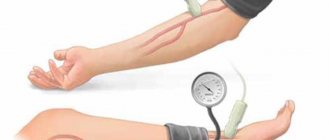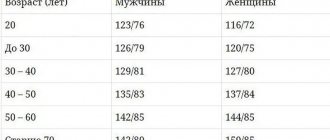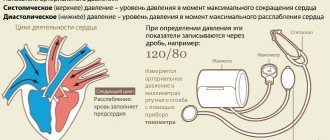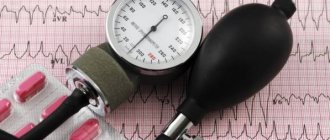Is it possible to measure blood pressure without a tonometer? This question interests many, since a deterioration in a person’s well-being can occur suddenly, in conditions where there are no medical devices at hand. Such methods exist. Let's look at them and talk about how accurate they are and whether the results obtained can be trusted.
By analyzing your pulse, you can get an idea of whether your blood pressure is high or low.
Blood pressure (BP) is the force with which blood acts on the walls of the arteries. This value is not constant. For example, during physical activity, muscles experience increased demands for oxygen and nutrients. As a result, the heart contracts with greater force, and blood pressure increases by 10-20 mm Hg. Art. When resting, the body's need for oxygen decreases, and a person's blood pressure returns to normal. Therefore, blood pressure should be measured by any method only at rest.
Normal blood pressure for an adult is in the range of 91–139/61–89 mmHg. Art. In this case, the absolute norm is 120/80 mmHg. Art.
How to recognize abnormal blood pressure
It is known that the deviation of blood pressure from the norm is more than 10-15 mm Hg. Art. leads to a deterioration in general health. Clinically, this can be manifested by the following symptoms:
- headache;
- weakness;
- dizziness;
- nausea.
When they appear, it is necessary to measure blood pressure using a special device. If it is not there, then you can try to use folk methods, which we will now consider.
Measuring technique
Determining blood pressure values without a tonometer requires special training, since this task cannot be completed without it.
You need to understand that measurements are influenced by factors such as daily routine and physical tension, stress and diet.
If you master this technique for measuring blood pressure and correctly calculate the readings, you will no longer need a tonometer.
Before taking measurements, you need to be able to completely relax. This is a necessary condition because it greatly influences the result. The pulse can be clearly seen in the wrist, neck or inside of the elbow.
So, the procedure is as follows:
- take a convenient and comfortable position (you can lie down);
- put your watch on the table next to you;
- relax;
- Place the fingers of your left hand on your wrist, neck or elbow (whichever is more convenient for you). Remember that clothing should not interfere with free blood circulation: remove things that tighten blood vessels;
- then count the number of beats in 30 seconds. If you doubt the result, repeat the measurement again;
- the resulting figure should be multiplied by two.
If you get 60 beats, your blood pressure is low. A value of 60-80 indicates normal blood pressure. More than 80 – high blood pressure.
As you can see, everything is simple. Having mastered this simple technique, you will confidently control your well-being. The main thing is not to ignore the body’s signals. After all, sometimes a headache or slight malaise is a consequence of manifestations of various pathologies that require urgent treatment.
How to find out blood pressure without a tonometer based on symptoms
This method does not allow direct measurement of pressure, but only indirect assessment of whether it is increased or decreased. In order to understand what pressure a person has, we suggest using the information from the table.
| Sign | Blood pressure is low | Blood pressure is elevated |
| Headache | Usually localized in the occipital part of the head, it is aching or pressing in nature | Pressing, pulsating. Most often localized in the temporal region |
| Dizziness | Happens often | Rarely seen |
| General weakness | Slight to very strong | Not typical |
| Skin color | Pale | Unchanged or reddened |
| Feeling of anxiety, excitement | Not typical | Occurs frequently |
| Drowsiness | Almost always | Rarely |
| Pulse | Normal or bradycardia (reduced) | Normal or tachycardia (rapid) |
| Nose bleed | Can not be | Observed with a significant increase in blood pressure |
| Nausea, vomiting | Almost never happens | Seen frequently. Vomiting may be repeated and does not bring relief. |
Analysis of pulse characteristics allows you to distinguish high blood pressure from low blood pressure.
Objective signs
Before determining blood pressure based on symptoms, it is worth taking note that all of the above criteria for designating blood pressure disorders are subjective. Here are a few parameters that are relevant to the human vascular system:
- Big belly. Excess fat indicates an unbalanced diet, aging, unhealthy lifestyle and disorders of the cardiovascular system. People with large bellies do not have normal blood pressure.
- Redness of the eyes. The prerequisite for high blood pressure is a symptom when there is redness not only on the eyeballs, but also on the face. Such manifestations of hypertension are especially dangerous in elderly people prone to myocardial infarction.
- Complexion. A hypotensive person has pallor of the skin, a thin face with a lifeless expression. Hypertensive patients have a red face, which often shows a vascular pattern.
- Pulse. If you find an artery and press well on it, but the heartbeats do not disappear, then you can consider the possibility of high blood pressure. With low blood pressure, the pulse will be weak, uneven and will disappear immediately after pressure.
How to check blood pressure without a tonometer using your pulse
Another way to indirectly assess blood pressure levels without any device is to analyze the frequency and strength of the pulse. The table shows the main characteristics of the pulse wave that you need to pay attention to.
| Pulse characteristics | Low blood pressure | High blood pressure |
| Pulse rate (number of waves per minute) | The pulse may be normal (60-90 beats per minute) or low (less than 60 beats per minute). Increased heart rate with low blood pressure is usually observed only against the background of massive blood loss | Tachycardia usually develops (pulse rate reaches 90 beats per minute or more). A normal pulse rate (60-90 beats per minute) is much less common. If a patient develops bradycardia due to hypertension, in most cases this indicates an acute cerebrovascular accident (stroke) |
| Pulse strength | Even light pressure with your fingers on the skin above the artery leads to the disappearance of the pulse wave | To stop the pulse wave, apply forceful pressure to the skin over the artery |
| Pulse voltage | Not tense, soft | Tense, soft |
Thus, analysis of pulse characteristics makes it possible to distinguish high blood pressure from low blood pressure.
Measuring blood pressure via smartphone
This is no longer a folk method, but a quite common modern practice. If you have a good, fairly powerful smartphone, you probably want it to not only allow you to access social networks anywhere. I would like to load it with useful applications, one of which is blood pressure measurement.
Choosing such applications is an interesting and easy task. There are several of them, almost all of them are simple and do not require special computer literacy. The principle of their operation is simple - you place your finger on the camera or smartphone screen. In just a few moments, the monitor receives data on your pulse, as well as SBP and DBP indicators. That is, in such a quick and not entirely traditional way you can find out your pressure.
Tonometer program for Android
For example, there is an application for Android called Tonometer. Interestingly, it can even be used to test vision and hearing. Place your finger on the camera flash and wait until the device analyzes the information. If your phone doesn't have a flash, this app won't work.
Application Features:
- Quickly measures blood pressure and heart rate;
- Includes tests to check hearing and visual analyzer functionality;
- Can work as a pedometer;
- The interface is clear and simple;
- There is even a section with fitness programs for pumping up the main zones;
- The Russian-language adaptation is far from perfect, but it is still understandable.
It’s interesting that this offer, although called Tonometer, is literally packed with functions. In addition to the above, it can measure the amount of oxygen in the blood and even the volume of the lungs.
Critics note: the pedometer in this program does not work entirely accurately, but the developers did their best on visual and auditory tests. There are many interesting materials on the Internet that describe complete testing of such programs. Real people, not interested in advertising applications, armed themselves with medical devices and compared data from their smartphone with a full check on medical equipment.
In particular, the Tonometer program has errors: for example, when measuring pressure, 95% of testers found errors within 12 divisions. But, as experts say, it is necessary to take into account not only the quality of the program development, but also whether the flash on the phone works well, and whether the user performed the measurement correctly.
How to determine pressure without a tonometer using a pendulum
How to measure blood pressure without a tonometer at home? This can be done using a ruler and a simple pendulum. There have been no clinical studies of this method, and it rather relates to bioenergetics and extrasensory perception than to medical science, therefore the results obtained cannot be called reliable.
Blood pressure should be measured by any method only at rest.
To measure pressure with a ruler and pendulum you need:
- Make a pendulum. To do this, take a thin cord (thick thread) 20-25 cm long, tie a small nut or ring to one end, leaving the other end free.
- Place the forearm of the person being examined on a flat horizontal surface, the palmar surface of the hand should be facing upward.
- Place a regular school ruler on your forearm so that its base lies on the elbow area.
- Take the pendulum in your hands and lower the ring above the zero division of the scale. It should be located as close to the ruler as possible, but not touch it.
- Start slowly moving your pendulum along the ruler towards your hand.
- Note at what segment of the scale the movements of the pendulum from chaotic will become of the same type, in the direction transverse to the surface of the ruler. Multiply the marked figure by 10. The result obtained will correspond to the systolic (upper) pressure.
- Turn the ruler over so that its base now rests in the crease between your hand and forearm.
- The pendulum should now be slowly moved from the hand towards the elbow joint.
- Also mark the point on the scale where the movements of the pendulum became clearly transverse. Multiply the resulting figure by 10. The result obtained corresponds to the lower (diastolic) pressure.
- Repeat the measurement procedure again.
As you can see, pressure can be measured using various available methods. However, the results obtained are very approximate, and even unreliable. Therefore, if a person suffers from hypertension or hypotension and needs regular blood pressure monitoring, it is necessary to purchase a tonometer at the pharmacy - a device for measuring blood pressure using the Korotkov method.
Deviation of blood pressure from the norm by more than 10-15 mm Hg. Art. leads to a deterioration in general health.
Where is the best place to check your pulse?
You can take measurements in the area of the femoral artery, in the groin area - the pulse can be heard well there. The armpit is also considered a suitable place. In the popliteal region we also find another pulse zone.
The dorsalis pedis artery is an unexpected but nevertheless appropriate location. And many people also measure their pulse on their neck, slightly below the jaw angle. You can clearly hear it there.
When measuring your heart rate, consider the following:
- Before taking measurements, you need to relax as much as possible;
- Go to the toilet - if you have been wanting to go there for a long time, the indicators may not be entirely correct;
- Do not smoke a couple of hours before the measurement - nicotine affects blood pressure;
- The position in which you take the measurement should be perfectly comfortable;
- During the procedure, do not move or stir, do not talk;
- If you have rings, bracelets, or watches on your hand, they should be removed during the measurement.
Keep up with the times: buy an inexpensive fitness bracelet. It is easy to maintain and looks like a stylish watch on your hand. By the way, it also shows the time. But in addition to counting the steps taken during the day, it also measures your pulse. Constantly. It also has an alarm function, calorie counting, and even a reminder that it’s time to walk (if it doesn’t record steps within an hour). A good gadget not only for those who are losing weight, but, in principle, for everyone who monitors their health.
What pressure is considered normal?
Normal blood pressure for an adult is in the range of 91–139/61–89 mmHg. Art. In this case, the absolute norm is 120/80 mmHg. Art.
However, it should be understood that normal blood pressure is an individual indicator for each person, the main thing is that it is within the above limits. For example, a blood pressure of 120/80 is normal for one person, high for another, and low for a third.
Low pressure (below 90/60 mm Hg) is called hypotension, and high pressure (above 140/90 mm Hg) is called hypertension.
Pendulum and ruler
Only a few people know how to find out pressure in this way, but it is not used for people with a hard-to-palpable pulse. It is necessary to prepare a pendulum (ring, needle, etc.), thick thread (45 cm), ruler (25 cm).
To get the correct result, you should understand the features of the procedure and try to prevent the upper limbs from shaking. High levels indicate high blood pressure and the development of hypertension.
How to carry out the procedure:
- Before this blood pressure measurement, you need to calm down and sit in this state for 5 minutes.
- A thread is threaded through the pendulum, the ends of which are connected.
- The hand is located at the level of the heart, a ruler is placed on it from the elbow to the wrist (inner side).
- The pendulum is held over the ruler at a close distance.
- The lower pressure limit is determined as follows: the number at which the device begins to oscillate is multiplied by 10.
- The upper blood pressure indicators are determined similarly when the pendulum swings again.
Setting up a tonometer at home
There are several tips on how to test the mechanism for serviceability at home. There is a special installation that shows a certain pulse and breathing of a person, which it simulates. The tonometer is calibrated according to these data. But such an installation is very expensive and not everyone can afford it at home. The second way is to connect two blood pressure monitors to one cuff, one of which will be precisely adjusted by a medical equipment specialist.
The reference tonometer can be set up in a pharmacy, after which you can calibrate your equipment using this data
An accurate device is necessary in the house, because its indicators can help to draw attention to the problem in time. It is necessary to check the equipment for malfunctions, and also always observe the correctness of the correct pressure measurement
What are the treatment methods?
Often, hypotension in women occurs as a result of one or another disease, so correct and timely diagnosis will help to find out the true cause of low blood pressure. Unfortunately, many patients are in no hurry to see a specialist, preferring to deal with the symptoms. So, strong coffee will increase blood pressure, and a Fanigan tablet will reduce the intensity of headaches.
Coffee to increase blood pressure
The treatment regimen for low blood pressure depends on the disease. If hypotension occurs due to a malfunction of the ovaries, thyroid gland or pituitary-hypothalamic system, then in this case hormonal treatment is prescribed, and in some cases even surgery.
For gynecological diseases, treatment is also long and difficult. If a woman is of reproductive age, then, as a rule, medications are prescribed; at an older age, it is preferable to undergo surgery.
For your attention, table No. 2 “Treatment of low blood pressure in women with medications”:
| Pharmacological group, drug name | Short description |
| General tonic substances and adaptogens (Ginseng tincture, Schisandra, Eleutherococcus, Pantocrine). | Drugs in this group are considered the “mildest” antihypertensive drugs. As a rule, they are of plant origin, but sometimes of synthetic origin. Medicines have a vasoconstrictor and tonic effect on the vascular center. The drugs improve overall well-being, eliminate fatigue and apathy, and improve night sleep. |
| Alpha adrenergic agonists (Gutron, Mezaton) | Medicines stimulate alpha-adrenergic receptors, which helps achieve vasoconstrictor and anticongestive effects. Medicines are usually prescribed for acute hypotension, when it is necessary to increase blood pressure as quickly as possible. |
| Analeptics (Cordiamin, Sulfocamphocaine, Etimizole) | Analeptic drugs have a stimulating effect on the respiratory vascular center of the brain, which helps stimulate circulatory function, increase the tone of the vascular walls, and improve the functioning of the heart muscles. The drugs reduce fatigue and eliminate weakness, improve performance and mood. |
Setting up tonometers for work
Specialists in medical institutions check devices using a professional installation that simulates a certain pulse and pressure. The tonometer is calibrated according to specific indicators, so doctors evaluate the quality of each specific tonometer. This requires the right to verify measuring instruments used to treat patients. Unfortunately, this option is not suitable at home.
What should ordinary people who do not work in clinics and hospitals do?
Tonometer calibration is a service that is offered in many pharmacies, especially those specializing in the sale of medical equipment. Specialists will carry out the setup and set the correct indicators. For this purpose, a reference device is used for comparison for accuracy.
Possible mistakes
Many people, when trying to measure blood pressure using their pulse rate, make mistakes and, as a result, receive false information about the state of their health. During diagnosis, it is necessary to take into account not only the number of heartbeats, but also their rhythm.
Sometimes it is arrhythmias that provoke pressure surges and in this case drug treatment is required. As soon as the heart muscle normalizes its rhythm, the unpleasant symptoms will disappear.
It is also a common mistake to measure your heart rate only from your wrist. The heartbeat can also be clearly heard in other areas - under the knee joint, on the temples, on the neck. It is important to compare the indicators obtained at different points and only then draw conclusions. Strong pulsation on one arm and weak pulsation on the other cannot be considered normal. Only a doctor can accurately calculate blood pressure using the pulse.
The inability to correctly interpret the data received or measure the pulse will lead you to many negative thoughts, which, as a rule, are one of the main causes of pressure surges.











